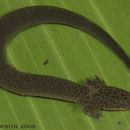fr
noms dans le fil d’Ariane


Siren intermedia is extremely rare and possibly extirpated in Michigan but this species is not threatened over most of its range. It could be harmed by chemicals such as Rotenone, which is used as a fisheries management tool and can be fatal to aquatic amphibians such as Siren intermedia. Another factor that may affect the vitality of this species is habitat destruction and the filling in of wetlands.
US Federal List: no special status
CITES: no special status
State of Michigan List: no special status
IUCN Red List of Threatened Species: least concern
Development - Life Cycle: metamorphosis
On occasion a Siren might take a fisherman's baited hook, but this would be an uncommon and minor annoyance. These animals are properly considered harmless to human interests.
Sirens are occasionally used for fish bait, but this species normally attracts little attention from humans. They occupy a predatory niche in shallow freshwater habitats, and have ecological value in the environment.
Siren intermedia feeds primarily on aquatic invertebrates such as crustaceans, insect larvae, worms, and snails. They will also readily consume young amphibian larvae and their own eggs. Siren intermedia often feeds by gulping large quantities of material at a time, which is filtered through the bronchial openings. Vegetable matter sometimes found in their digestive tracts is probably eaten accidentally.
Animal Foods: insects; terrestrial non-insect arthropods; mollusks; terrestrial worms; aquatic crustaceans
Primary Diet: carnivore (Insectivore , Eats non-insect arthropods, Molluscivore , Vermivore)
Siren intermedia, the Lesser Siren, ranges from the Coastal Plains of Virginia to Florida, then westward to southern Texas and northeastern Mexico. Populations extend northward in the Mississippi Valley to Illinois, Indiana, and southwestern Michigan. Geographic isolates occur in northern Indiana, southwest Michigan, northeastern North Carolina, and southeastern Virginia.(Petranka 1998) This range is occupied by three subspecies, they are S. i. intermedia, S. i. nettingi, and S. i. texana. All of these subspecies only vary slightly in physical characteristics such as length and color (Conant and Collins, 1998).
Biogeographic Regions: nearctic (Native )
Siren intermedia will inhabit most any slow and sluggish body of water that is shallow and with plenty of aquatic vegetation, including marshes, ponds, ditches, and canals. In most circumstances they need a permanent or semi-permanent body of water but they are able to move short distances over land if factors are right or stay encased in a cocoon of slime if drought occurs.
Habitat Regions: temperate ; freshwater
Aquatic Biomes: lakes and ponds
Wetlands: marsh ; swamp ; bog
Average lifespan
Status: captivity: 6.3 years.
Siren intermedia is an eel-like salamander with a long slender body (18-68 cm long) and a very small dorsal fin that runs from the vent to the tail tip. It has only a pair of front legs; each foot has four toes. The front legs are very reduced and the rear legs are completely absent. The head is rather flattened, and there are bushy external gills located on each side of the head. Siren intermedia varies in coloration from light grayish green to olive or black; there are also small irregular markings (dots) that are visible on lighter colored individuals.
Larvae and juveniles are more brightly marked, with a red band across the nose and along the side of the head.
Other Physical Features: endothermic ; ectothermic ; heterothermic ; bilateral symmetry
The courtship behavior of Siren intermedia has not yet been described. Fertilization has been presumed to be external, since the females lack cloacal sperm storage areas. There is thought to be a lot of aggression during mating due to the amount of scaring from bite marks on both the males and females. Eggs are laid in early spring they are deposited in shallow depressions in the soft bottom of the occupied water body, usually in highly vegetated areas. In these shallow depressions the female will lay from 12 to over 300 eggs; the female may lay multiple clutches through out the season. Freshly laid eggs are dark brown and 2.5-3 mm in diameter. The hatchling larvae are about 1.1 cm in length. (Petranka 1998; Harding 1997)
Key Reproductive Features: gonochoric/gonochoristic/dioecious (sexes separate)
Average number of offspring: 200.
Average age at sexual or reproductive maturity (male)
Sex: male: 730 days.
Average age at sexual or reproductive maturity (female)
Sex: female: 730 days.